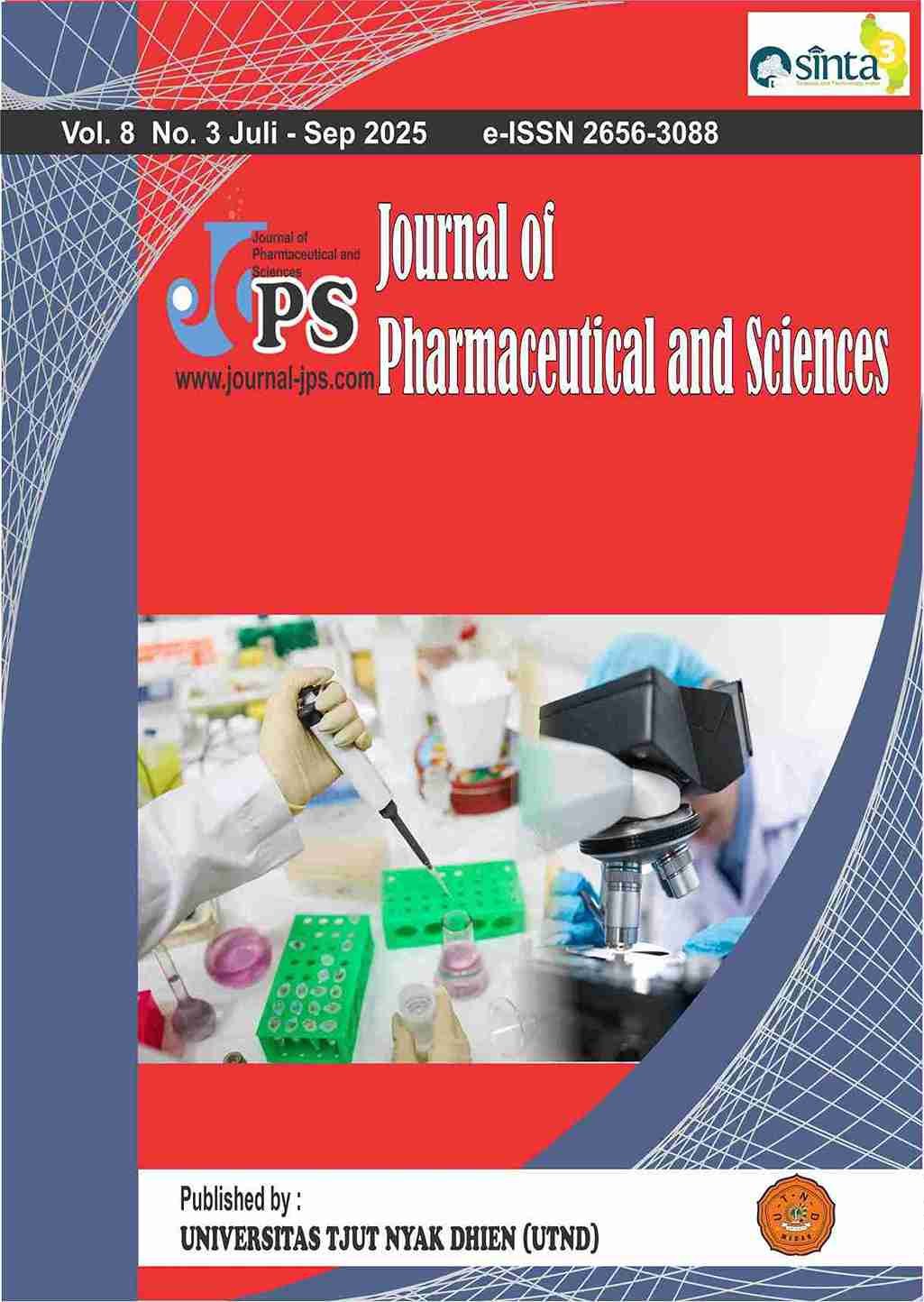The Relationship of Knowledge, Parenting Patterns, Feeding, and Environmental Sanitation to the Incidence of Stunting in Toddler Ages 24-59 Months in the Working Area of the Buhit Puskesmas, Samosir District, 2025
Main Article Content
Page: 2107-2117
Abstract
Background: Stunting is a chronic nutritional problem with profound implications for the quality of human resources. Multiple factors, including parental knowledge, feeding practices, and environmental sanitation, influence this condition. The working area of the Buhit Community Health Center (Puskesmas Buhit) in Samosir Regency continues to face challenges in addressing stunting, making the identification of dominant factors essential for targeted interventions. Objective: This study aims to analyze the relationship between parental knowledge, feeding practices, and environmental sanitation with the incidence of stunting among children aged 24–59 months, and to identify the most influential factor in the Buhit Community Health Center service area, Samosir Regency, in 2025. Methods: This research employed an observational analytic design with a cross-sectional approach. The study population comprised all children aged 24–59 months (n = 577). A total of 88 respondents were selected using simple random sampling and the Slovin formula. Data were collected through questionnaires and anthropometric measurements, and analyzed using Chi-square tests and logistic regression. Results: Bivariate analysis revealed a significant association between parental knowledge (p = 0.000), feeding practices (p = 0.000), and environmental sanitation (p = 0.004) and the incidence of stunting. Multivariate analysis revealed that feeding practices were the most dominant factor (OR = 105.463; 95% CI = 13.888–800.848). This indicates that children with inadequate feeding practices have a 105.463-fold higher risk of stunting compared to those with good feeding practices. Conclusion: A significant relationship exists between parental knowledge, feeding practices, environmental sanitation, and the incidence of stunting. The most dominant factor is feeding practices. Therefore, stunting prevention interventions in this area should focus on improving parents’ understanding and implementation of appropriate feeding practices.
Downloads
Article Details

This work is licensed under a Creative Commons Attribution-NonCommercial-ShareAlike 4.0 International License.
References
World Health Organization. Stunting in a nutshell. World Health Organ 2025. https://www.who.int/news/item/19-11-2015-stunting-in-a-nutshell.
Kemenkes, RI. Health Statistics (Health Information System). 2020. https://doi.org/10.5005/jp/books/11257_5. DOI: https://doi.org/10.5005/jp/books/11257_5
Ri K. Hasil Studi Status Gizi Balita Indonesia (SSGBI) tahun 2019. Jakarta: 2019.
Noordiati N, Hikmah N, Wahyuni S, Sukriani W, Arisani G. Analisis Faktor Risiko Stunting Pada Anak Usia 12-59 Bulan. J Ilmu Kesehat Masy 2022;11:495–501. https://doi.org/10.33221/jikm.v11i06.1807. DOI: https://doi.org/10.33221/jikm.v11i06.1807
Meiyetriani E, Utomo B. Improved sanitation and co-occurrence of anemia and stunting in Indonesian children: A retrospective cohort study. Narra J 2025;5:e2070. DOI: https://doi.org/10.52225/narra.v5i1.2070
Kemenkes. Survei Kesehatan Indonesia. Jakarta: 2023.
Muhammad NAAS. Penyakit Infeksi Dan Pola Makan Dengan Kejadian Status Gizi Kurang Berdasarkan Bb/U Pada Balita Usia 6-24 Bulan Di Wilayah Kerja Puskesmas Tanah Sepenggal. Kementeri PPN/Bappenas 2018;7:66.
Sapriana S, Sasmita H, Novarianti N. Pembuatan Jamban Keluarga untuk Rumah Tangga dengan Kasus Stunting di Wilayah Kerja Puskesmas Wani. Poltekita J Pengabdi Masy 2023;4:259–67. DOI: https://doi.org/10.33860/pjpm.v4i1.1477
Sugiyono. Metodologi Penelitian Kuantitatif Kualitatif dan R&D. Bandung: Alfabeta; 2019.
Sugiyono. Metode penelitian manajemen. Bandung Alf CV 2016.
Ningtyas YP, Udiyono A, Kusariana N. Pengetahuan Ibu Berhubungan Dengan Stunting Pada Balita Di Wilayah Kerja Puskesmas Karangayu Kota Semarang. J Kesehat Masy 2020;8:107–13.
Dewi NWEP, Ariani NKS. Hubungan pengetahuan ibu tentang gizi menurunkan resiko stunting pada balita di Kabupaten Gianyar. Menara Med 2021;3.
Puspasari N, Andriani M. Hubungan pengetahuan ibu tentang gizi dan asupan makan balita dengan status gizi balita (BB/U) usia 12-24 bulan. Amerta Nutr 2017;1:369–78. DOI: https://doi.org/10.20473/amnt.v1i4.7136
Syafei A, Afriyani R. Hubungan pola asuh pemberian makan dengan kejadian stunting. J Kesehat Dan Pembang 2023;13:1–5. DOI: https://doi.org/10.52047/jkp.v13i25.217
Prihati DR, Nurrasyidah R, Kuswati K. Status Gizi Remaja Putri Di Puskesmas Klaten Selatan. Bunda Edu-Midwifery J 2023;6:5–10. DOI: https://doi.org/10.54100/bemj.v6i1.81
Laili U, Putri EBP, Rizki LK. Peran pendamping keluarga dalam menurunkan stunting. Media Gizi Indones 2022;17:120–6. DOI: https://doi.org/10.20473/mgi.v17i1SP.120-126
Laili AN, Munawir A, Ningtyias FW. The Influence of Parenting Patterns on Stunting Incidences in Toddlers (Study in the Work Area of Sumberjambe Health Center, Kasiyan Health Center, and Sumberbaru Health Center, Jember Regency). J Qual Public Heal 2021;5:256–60. DOI: https://doi.org/10.30994/jqph.v5i1.239
Fikawati S, Syafiq A. Maternal calorie intake is a significant factor associated with 6 months of exclusive breastfeeding among lactating mothers in Depok City, Indonesia. Malays J Nutr 2017;23.
Indra Budi Antari Luh. Hubungan Pola Asuh Orang Tua dengan Kejadian Stunting pada Balita Usia 24-59 Bulan 2020.
Erlina DNPM. Hubungan Pola Asuh Orang Tua Dengan Kejadian Stunting Pada Balita Usia 24-59 Bulan Di Puskesmas Banjar II 2020.
Ramadanty A, Putriani P, Hibana H, Na’imah N, Ayu SM. Pengaruh Pola Asuh Permisif Terhadap Perkembangan Sosial Emosional Anak Usia Dini di TK Al-Hidayah Kabupaten Bone. Gener Emas 2022;5:67–82.
Adhani JP, Lahdji A, Faizin C. Analisis faktor risiko kejadian stunting pada balita di wilayah kerja Puskesmas Karanganyar I Kabupaten Demak. J Ilmu Kedokt Dan Kesehat 2024;11:430–9. DOI: https://doi.org/10.33024/jikk.v11i2.10600
Ainy FN, Susanto T, Susumaningrum LA. The relationship between environmental sanitation of the family and stunting among under-five children: A cross-sectional study in the public health center of Jember, Indonesia. Nurs Pract Today 2020. DOI: https://doi.org/10.18502/npt.v8i3.5932
Wulandari Y, Arianti M. Faktor–faktor yang berhubungan dengan kejadian stunting pada balita. J Keperawatan Bunda Delima 2023;5:46–51. DOI: https://doi.org/10.59030/jkbd.v5i1.68





